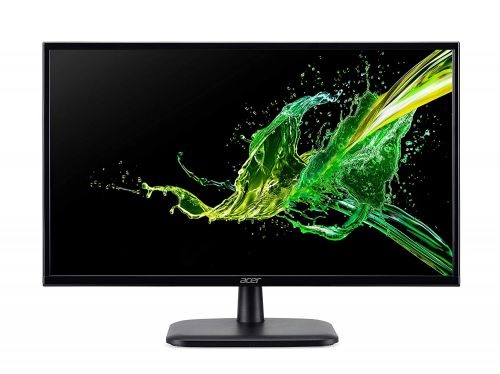When you are looking to purchase a monitor for your computer, you will come across two categories of monitors broadly. They are LCD and LED monitors, and it is going to be quite confusing for you to decide which one to buy unless you have proper knowledge about them.
Both types of monitors have their equal share of pros and cons, and they have several variants to choose from. In this article, we will discuss all the different aspects of LCD and LED monitors so that you can decide which one is best for you.
Outline
ToggleLCD Monitor & How it Works?
An LCD monitor has thousands of pixels that can display light. LCD stands for liquid crystal display and the pixel has different layers which make the monitor work.
- In the first layer, a polarizing film sheet uses the light waves from behind. It filters out the vertical light waves and only the horizontal waves are left.
- In the second layer, there are more than three layers. In two of them, you will find protective glass with liquid crystal on the inside. The crystals keep them in place and prevent them from getting damaged.
- The third layer is also a polarization sheet and filters the horizontal light out.
- Finally, there is a fourth layer that is responsible for color changes. It has three light filters on each pixel that provide blue, green, and red colors.
Now let’s see how LCD monitors work. During the absence of electricity, liquid crystals can rotate and twist to up to 90 degrees. This further lets the light flow through the crystals. During this process, the light will pass through the second filter and it will go through the green, red, or blue light filter. When there is electricity, liquid crystals block the light from behind which can turn the pixel off. When you look at the LCD screen, there are individual pixels of different colors.
Pros & Cons of LCD Monitors
Here are the advantages and disadvantages of LCD monitors you should be aware of.
Pros
- The lifespan of an LCD monitor is around 30,000 hours. This means if you use it for 10 hours a day, it can have a longevity of 8 years.
- There is no burn-in issue with LCD monitors and hence, they are best for gamers. Burn-in issue refers to an image getting stuck on the screen when it is shown for too long.
- You will find HDR elements in some models which enhances the visual impact.
- LCD monitors are available at an affordable value in comparison to the latest monitors.
Cons
- LCD monitors can be heavier and thicker.
- LCD monitors can run hot and consume more power.
- Most of the monitors don’t come with 4K compatibility.
- It can have mercury that leads to pollution, especially after some years of usage.
- It can provide less clarity due to lower contrasts.
Types of LCD Monitors
- TN Panels:One of the first LCD monitors was of TN panel. Twisted Nematic has improved response time and is being used in some of the fastest gaming monitors. It also supports an extremely fast refresh rate of 240 Hz. With this refresh rate, there will be reduced motion blur as well as image transition smoothness.
- VA Panels:Also called the vertical alignment panel, this came into existence in the 1990s. The VA panel is aligned vertically and has liquid crystals. It can produce deep blacks with a vibrant array of colors. One of the best things about the VA panel is that it can also provide better contrast. However, compared to the TN panel, it has a slower refresh rate. Another disadvantage is that it can cost more and is not a popular LCD panel technology.
- IPS Panels:The best LCD panel technology is the IPS or in-plane switching panels. It can provide wide viewing angles and supports faster refresh rates. Even though it is not as fast as TN panels, the IPS panel comes with a refresh rate of 144 Hz. The IPS panel also provides excellent color reproduction.
Therefore, if you are opting for an LCD monitor, go for an LCD monitor that has an IPS panel.
About LED Monitors & How it Works?
Both LCD and LED monitors work in the same way. However, LED or light-emitting diodes come with LED backlighting. With LED backlighting, there will be sharp contrast and bright colors. Additionally, LED monitors are also slim in size and make sure there will be maximum energy efficiency.
LED backlighting comes with a higher refresh rate so that there will be a fast response time. There are many types of LED backlighting like array-lit and edge-lit that help to provide the perfect image. Array-lit monitors are behind the screen and edge-lit monitors are around the edges. You can even find the one that can come with local dimming capabilities for deeper blacks.
Pros & Cons of LED Monitors
Here are the advantages and disadvantages of LED monitors you should be aware of.
Pros
- LED monitor has a lifespan of 50,000 hours and this means you can use the monitor roughly 15 years with 8-10 hours of usage per day.
- It provides a sharper image and higher color quality with better contrast.
- It delivers energy-efficient performance for saving power.
- The slim design helps to save space and makes it look sleek.
- It supports 4K resolution that helps to run the latest movies and videos as well as high-end games.
- It is free from mercury so that there will be no pollution issue.
- LCD monitor supports fast response time making it ideal for gaming purposes.
Cons
- There is a high risk for screen burn or image retention.
- Higher initial price point and relatively expensive.
Types of LED Monitors
- Edge-Lit LED:One of the best things about Edge-Lit LED is that it comes in a slim design. It uses fewer LEDs that help to lower the new screen cost. An Edge-Lit LED monitor has a rim of LED on the display while facing the screen. This makes sure there will be uniformity of screen that helps to create the image. However, it does come with a disadvantage. It has dark contrast and features the brightest closer on the edges. This can lead to black levels and color uniformity. It can provide some areas looking darker than others.
- Full-Array LED:In the Full-Array LED display, there is a grid of LED lights right behind the LCD. It can create a uniform and bright picture as the LEDs shine outwards. Even full array LED panels offer efficiency benefits of LED. An advantage of having this type of monitor is that it can come with local dimming. It helps the group of LEDs to switch on and off when you need it. This helps to provide optimum brightness level as well as control.
- RGB LED:LEDs don’t produce pure white light. However, it is closer to yellow. When there is a difference, it can lead to a color shift in the image. Owing to this, some manufacturers have come up with white LEDs with groupings of RGB (red, green, and blue) LEDs. When there is a combination of RGB LED colors, it helps to provide pure white so that there will be true and clear colors. RGB LED uses advanced programming and electronics for vivid colors. This can lead to an increase in the cost of the RGB LED screen.
- OLED:An advanced form of LED lighting is OLED. Organic Light-Emitting Diodes can dim or glow independently so that there will be better black levels. It also helps to improve the contrast ratio and make sure there will be sharp colors. Additionally, OLED monitors and TVs come with excellent color quality and viewing angles. In this type of monitor, you will find a high dynamic range programming for better color accuracy. It has a better color depth making it perfect for a smartphone screen. However, it consumes a lot of power and is expensive.
- QLED:Quantum Dot LED or QLED improves color accuracy by 90% compared to a regular LED monitor. With it, there will be high levels of color depth and brightness. Quantum dots are in the form of semiconductor nanocrystals that provide different wavelengths. It reflects the blue LED light into red and green shades for a complete picture. In a single Quantum dot monitor, there are billions of nanocrystals that give outstanding color depth and black range.
Comparison of LCD Monitors and LED Monitors –
Here is the complete comparison of LCD and LED monitors on various parameters.
Is LCD or LED better for Gaming?
For gaming, you need a monitor that has a low response time and a high refresh rate. Response time is the time a monitor takes to change pixels when it moves from one image to another. High refresh rate is needed to avoid any lag issue. On all these parameters, LED monitors score higher than LCD monitors, and on top of that, the picture and video quality and clarity are better in LED monitors.
Is LCD or LED better for higher Picture Quality?
The primary difference between LED and LCD monitors is the picture quality. LED monitors have far better picture quality than LCD monitors. You will understand it only when you play high-quality videos or play high-end games. Starting from sharper and clearer picture to faster rendering and refresh rate, LED monitors score over LCD monitors in terms of picture quality.
Is LCD or LED better for Energy-Efficiency?
LED monitors are more energy-efficient than LCD monitors. The light-emitting diodes consume less power. In fact, if you compare the energy consumption, an LED monitor of size 32-inch will consume 10W less power than an LCD monitor of the same size. The bigger the size, the bigger will be the difference in power consumption.
Is LCD or LED better for Longevity?
The LED monitor has a lifespan of 50,000 hours, while the lifespan of an LCD monitor is around 30,000 hours. Naturally, the longevity of LED monitors is longer, and hence, it is compensated for in its price. Additionally, LED monitors are thinner and lighter than LCD monitors of the same size.
Comparison Table Between LCD Monitors and LED Monitors –
| Parameters | LCD Monitor | LED Monitor |
| Working Principle | Makes use of the light modulating feature of liquid crystals. | Makes use of light emitting diodes. |
| Picture Quality | Moderate | Great |
| Burn-in Issue | No | Yes |
| Lifespan | Less | More |
| Thickness and Weight | Thicker and heavier | Slim and lightweight |
| Eye Comfort | Moderate | Highly comfortable |
| Energy Efficiency | Moderate | Highly Efficient |
| Environment harm due to Mercury | Yes | No |
| Cost | Affordable | Expensive |
Conclusion – Which Is Better — an LCD or LED Monitor?
Except for burn-in issues and cost, LED monitors beat LCD monitors on all parameters. Therefore, if budget is not an issue for you, an LED monitor should be your first priority. As a matter of fact, if you are buying a monitor for gaming and video streaming, there is no alternative to an LED monitor. However, if you are buying a monitor for regular work and there is a budget constraint, you can do it with an LCD monitor pretty well.



